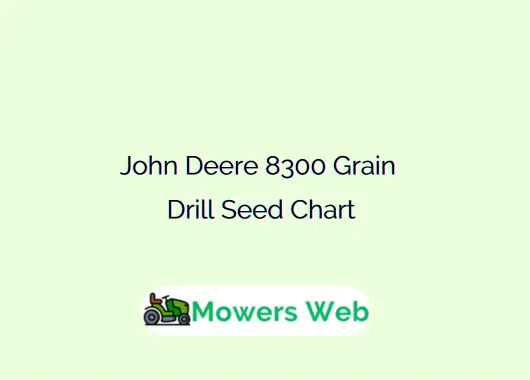To get the best results from the 8300 drill, it is important to set the correct seed rate, monitor drill depth, and adjust the seed cups and feed mechanisms according to the crop you are planting.
The seed chart below provides recommended seeding rates (per acre) and typical drill settings for the John Deere 8300.
John Deere 8300 Grain Drill Seed Chart
| Crop | Seed Rate (lbs/acre) | Seed Size / Notes | Drill Setting (Approx. Lever/Notch) | Row Spacing Used |
|---|---|---|---|---|
| Wheat (Soft/Hard Red) | 90–120 lbs | Standard grain seed | 18–22 notch | 7″ or 10″ |
| Soybeans | 45–70 lbs (drilled) | Larger seed; check seed plate | 8–14 notch | 7″ or 10″ |
| Oats | 70–90 lbs | Light grain; flows easily | 16–19 notch | 6″–7″ |
| Barley | 70–100 lbs | Medium grain | 15–18 notch | 7″ |
| Rye | 80–110 lbs | Fine grain; easy flow | 18–20 notch | 7″ or 10″ |
| Triticale | 90–120 lbs | Mix grain type | 17–22 notch | 7″ |
| Millet (Foxtail/Pearl) | 20–35 lbs | Very small seed | 4–8 notch | 7″ |
| Sorghum (Grain) | 4–10 lbs | Very small seed | 3–6 notch | 7″ |
| Sudan Grass | 25–40 lbs | Small seed | 6–10 notch | 7″ |
| Alfalfa | 10–20 lbs | Fine seed; use grass box if equipped | Grass Box 6–10 | 6″ |
| Timothy Grass | 2–8 lbs | Very fine seed | Grass Box 4–7 | 6″ |
| Clover (Red/White) | 6–12 lbs | Very fine seed | Grass Box 5–9 | 6″ |
| Canola / Rapeseed | 4–8 lbs | Small round seed | 3–7 notch | 7″ |
| Fescue | 8–20 lbs | Fine grass seed | Grass Box 6–11 | 6″ |
| Brome Grass | 15–25 lbs | Fluffy seed; may require agitator | Grass Box 9–14 | 6″ |
| Wildflower Mix | 8–15 lbs | Light seed mix | Grass Box 4–8 | 6″ |
| Cover Crop Mix (Rye + Clover) | 20–40 lbs total | Depends on ratio | Rye: 12–16, Clover: 5–8 | 7″ |
| Peas (Field/Forage) | 100–180 lbs | Large round seed | 20–25 notch | 7” |
| Sunflower (Oilseed) | 5–12 lbs | Larger seed, moderate flow | 8–12 notch | 7″ |
| Corn (Broadcast via Drill) | 15–25 lbs | Not for precision rows; cover crop use | 10–15 notch | 7″ |
| Winter Wheat (Thick Stand) | 130–160 lbs | Heavier seeding for late planting | 22–26 notch | 7″ |
| Flax | 15–25 lbs | Small smooth seed | 8–12 notch | 7″ |
| Chickpeas (Garbanzo) | 90–150 lbs | Large seed; needs depth | 18–24 notch | 7″ or 10″ |
| Mustard | 4–7 lbs | Fine seed | 3–6 notch | 7″ |
| Lentils | 40–75 lbs | Small round seed | 10–14 notch | 7″ |
| Camelina | 3–6 lbs | Very tiny seed | 2–5 notch | 7″ |
| Teff Grass | 4–8 lbs | Extremely fine seed | Grass Box 3–6 | 6″ |
| Crimson Clover | 12–20 lbs | Medium small seed | Grass Box 7–12 | 6″ |
| Hairy Vetch | 20–30 lbs | Large vine seed | 14–18 notch | 7″ |
| Annual Ryegrass | 15–25 lbs | Small grass seed | Grass Box 8–13 | 6″ |
| Buckwheat | 40–60 lbs | Fast cover crop | 12–17 notch | 7″ |
Related John Deere Planter Plates Chart(For All Models)
Tips for Accurate Seeding with the John Deere 8300
1. Perform a Calibration Test
Different seed varieties and moisture levels can cause slight differences in seed flow. Always:
- Lift the drill
- Turn the ground wheel several rotations
- Weigh the seed released
- Adjust settings based on results
2. Adjust Depth Correctly
- Small seeds (alfalfa, clover): ¼” to ½” depth
- Medium grains (wheat, oats, rye): 1″ depth
- Larger seeds (soybeans, peas): 1½”–2″ depth
Consistent depth equals uniform germination.
3. Inspect Seed Tubes and Openers
Clogged tubes or worn openers can lead to uneven seeding. Check:
- Discs
- Seed drop tubes
- Press wheels
- Replace worn parts for best performance.
4. Consider Seedbed Conditions
- Firm seedbed = better seed-to-soil contact
- Avoid drilling into extremely loose or wet ground
- If conditions are dry, slightly increase the seeding rate
5. Use the Grass Seed Box When Needed
Fine seeds such as clover, timothy, and fescue work best in the grass seed box, not the main grain box.
Related John Deere 7200 Planter Rate Chart(Complete Guide)
Why Farmers Still Love the John Deere 8300
Even though many newer no-till and air drill models exist, the 8300 remains popular because it is:
- Simple to maintain
- Durable and long-lasting
- Easy to calibrate
- Affordable on the used market
- Versatile for grain and cover crops
Its mechanical reliability means fewer breakdowns and consistent seed placement year after year.
Related John Deere 7000 Planter Sprocket Chart for Corn
FAQs
How many bushels does a John Deere 8300 drill hold?
A typical John Deere 8300 grain drill holds around 40 to 60 bushels, depending on row spacing and box configuration (single or double seed box). Most common 24×6 and 18×7 setups are in the 50–55 bushel capacity range.
How much is a John Deere 8300 grain drill?
Used market prices generally range from $2,000 to $9,000, depending on condition, width, seed box configuration, tire condition, and whether it includes a grass seed box or press wheels. Well-maintained units with full features tend to be on the higher end.
How much HP is a John Deere 8300?
The John Deere 8300 tractor (often paired with the drill) is rated at 200–225 horsepower, depending on the production year and configuration.
Is a John Deere 8300 a no-till drill?
No, the standard John Deere 8300 is not a no-till drill. It is designed for conventional or minimal tillage seedbeds. However, some farmers add aftermarket coulters or heavier down-pressure kits to improve performance in firm ground or light no-till conditions.
Related John Deere Combine Settings Chart(Ultimate Guide)
How fast should you pull a grain drill?
Ideal seeding speed is 4–6 mph. Running too fast can cause:
- Poor seed depth control
- Row skipping
- Inconsistent seed placement
- Slower speed improves uniform seed-to-soil contact and emergence.
What year did the John Deere 8300 come out?
The John Deere 8300 grain drill began production in the late 1970s through the 1980s, with variations and updates continuing through the early 1990s before newer series models replaced it.
Final Thoughts
The John Deere 8300 grain drill is a dependable and versatile seeder that can handle a wide range of crops and cover mixes. By using the correct seed rate settings, depth adjustments, and grass seed box options, you can achieve consistent plant stands and strong yields.
Use the seed rate chart above as a starting point, and always fine-tune based on your seed variety, field conditions, and planting goals.




